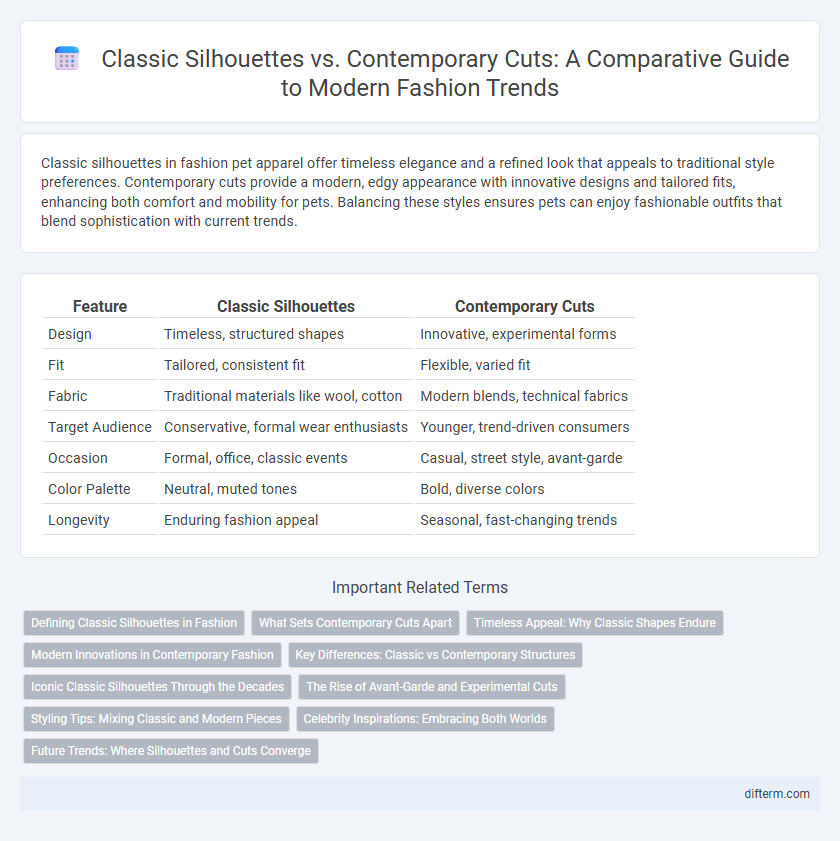Classic silhouettes in fashion pet apparel offer timeless elegance and a refined look that appeals to traditional style preferences. Contemporary cuts provide a modern, edgy appearance with innovative designs and tailored fits, enhancing both comfort and mobility for pets. Balancing these styles ensures pets can enjoy fashionable outfits that blend sophistication with current trends.
Table of Comparison
| Feature | Classic Silhouettes | Contemporary Cuts |
|---|---|---|
| Design | Timeless, structured shapes | Innovative, experimental forms |
| Fit | Tailored, consistent fit | Flexible, varied fit |
| Fabric | Traditional materials like wool, cotton | Modern blends, technical fabrics |
| Target Audience | Conservative, formal wear enthusiasts | Younger, trend-driven consumers |
| Occasion | Formal, office, classic events | Casual, street style, avant-garde |
| Color Palette | Neutral, muted tones | Bold, diverse colors |
| Longevity | Enduring fashion appeal | Seasonal, fast-changing trends |
Defining Classic Silhouettes in Fashion
Classic silhouettes in fashion are characterized by timeless shapes such as the A-line skirt, tailored blazers, and pencil dresses that emphasize clean lines and balanced proportions. These designs prioritize elegance and simplicity, often featuring structured tailoring and minimal embellishments to maintain versatility across seasons. Iconic pieces like the trench coat and little black dress serve as benchmarks, reinforcing the enduring appeal of classic silhouettes in wardrobe staples.
What Sets Contemporary Cuts Apart
Contemporary cuts distinguish themselves through innovative tailoring techniques that emphasize asymmetry, unconventional shapes, and fluid movement, creating a dynamic contrast to traditional classic silhouettes defined by structured, timeless forms. These modern designs often incorporate advanced fabrics and experimental patterns that enhance both comfort and aesthetic appeal, targeting a fashion-forward audience seeking individuality. By prioritizing versatility and trend-responsive elements, contemporary cuts offer a fresh, personalized approach to style that evolves with current cultural and design influences.
Timeless Appeal: Why Classic Shapes Endure
Classic silhouettes, characterized by their clean lines and balanced proportions, maintain timeless appeal by offering versatility and elegance that transcends fleeting trends. These designs, such as the A-line skirt, tailored blazers, and sheath dresses, adapt effortlessly to various occasions, ensuring longevity in a dynamic fashion landscape. The enduring popularity of classic shapes highlights their ability to provide a polished and sophisticated aesthetic that contemporary cuts sometimes lack.
Modern Innovations in Contemporary Fashion
Modern innovations in contemporary fashion prioritize cutting-edge materials and digital tailoring techniques that enhance fit and comfort, contrasting with the timeless elegance of classic silhouettes defined by structured forms and traditional craftsmanship. Designers incorporate sustainability-driven fabrics and 3D printing technology to push the boundaries of contemporary cuts, creating dynamic shapes that adapt to the wearer's movement. The fusion of technology and design transforms contemporary fashion into a versatile, functional art form that redefines modern aesthetics beyond classic constraints.
Key Differences: Classic vs Contemporary Structures
Classic silhouettes emphasize timeless shapes with structured tailoring, defined waistlines, and balanced proportions that flatter a wide range of body types. Contemporary cuts prioritize innovation and fluidity, featuring asymmetrical lines, deconstructed elements, and unconventional shapes that challenge traditional fashion norms. Key differences lie in the rigidity of classic structures versus the experimental and often dynamic forms of contemporary designs.
Iconic Classic Silhouettes Through the Decades
Iconic classic silhouettes such as the A-line dress, pencil skirt, and tailored blazer have defined fashion through the decades by emphasizing timeless elegance and flattering shapes. These designs, rooted in mid-20th-century fashion revolutions, continue to inspire contemporary cuts that blend tradition with modern minimalism. The enduring appeal of classic silhouettes lies in their versatility and ability to adapt to evolving style trends while maintaining structural integrity and sophistication.
The Rise of Avant-Garde and Experimental Cuts
Avant-garde and experimental cuts are transforming classic silhouettes by introducing asymmetry, exaggerated proportions, and unexpected fabric combinations. Designers such as Rei Kawakubo and Iris van Herpen push the boundaries of traditional fashion, creating innovative shapes that challenge conventional structure. This shift from timeless elegance to bold, artistic expression marks a significant evolution in contemporary fashion design.
Styling Tips: Mixing Classic and Modern Pieces
Classic silhouettes, such as A-line dresses and tailored blazers, provide a timeless foundation that balances perfectly with contemporary cuts like asymmetrical hems and oversized sleeves. Styling tips emphasize pairing structured classic pieces with edgy modern accessories, such as chunky sneakers or statement belts, to create a harmonious contrast. Combining these elements enhances outfit versatility, allowing for elegant yet fashion-forward looks that suit various occasions.
Celebrity Inspirations: Embracing Both Worlds
Celebrity inspirations often blend classic silhouettes with contemporary cuts to create timeless yet modern fashion statements. Iconic figures like Rihanna and Harry Styles frequently pair structured blazers or A-line skirts with edgy, asymmetrical designs, highlighting a seamless fusion of old and new. This hybrid approach enhances versatility, allowing individuals to showcase personal style while honoring fashion heritage.
Future Trends: Where Silhouettes and Cuts Converge
Future fashion trends reveal a convergence between classic silhouettes and contemporary cuts, merging timeless shapes with modern tailoring innovations. Designers are blending structured lines like A-line skirts and tailored blazers with asymmetrical hemlines and experimental fabric draping to create versatile, hybrid styles. This fusion highlights a growing demand for garments that balance heritage craftsmanship with futuristic aesthetics, driving evolution in both ready-to-wear and haute couture collections.
Classic silhouettes vs contemporary cuts Infographic

 difterm.com
difterm.com